Papers by Rabiu Mohammed Sani

The study was conducted to determine the effects of policy factors of land administration on the ... more The study was conducted to determine the effects of policy factors of land administration on the technical efficiency of irrigated rice production in the Dadin Kowa Irrigation Scheme (DKIS) area. A structured questionnaire was used for data collection. Three hundred and twenty irrigated rice farmers were selected using multi-stage sampling technique drawn from five land administration institutions in the DKIS area. Descriptive statistics, stochastic frontier, and multiple regression models were used to analyze the data. The technical efficiency (TE) analysis revealed that for the sample, farm size (P<0.01), fertilizers (P<0.05), herbicides (P<0.05), and pesticides (P<0.01) were all significant and negative while labour was positive (P<0.01). The inefficiency model for TE revealed that for the sample, four variables education, household size, access to improved seeds, and distance to market were each statistically significant at 5% probability level and negative (except for education which was positive). The effects of five policy factors of land administration (land governance, partnership in land use, socioeconomic factors, gender and inclusiveness, institutional and environmental factors) on TE revealed that for the aggregate sample, only land governance (P<0.01) and socioeconomic factors (P<0.05) were significant. The study recommended that the five policy factors of land administration should be accorded priority in strategic policy planning and implementation of programme for improving the productivity of irrigated agriculture and the livelihoods of people in the study area.
in 1975, provides research-based policy solutions to sustainably reduce poverty and end hunger an... more in 1975, provides research-based policy solutions to sustainably reduce poverty and end hunger and malnutrition. IFPRI's strategic research aims to foster a climate-resilient and sustainable food supply; promote healthy diets and nutrition for all; build inclusive and efficient markets, trade systems, and food industries; transform agricultural and rural economies; and strengthen institutions and governance. Gender is integrated in all the Institute's work. Partnerships, communications, capacity strengthening, and data and knowledge management are essential components to translate IFPRI's research from action to impact. The Institute's regional and country programs play a critical role in responding to demand for food policy research and in delivering holistic support for country-led development. IFPRI collaborates with partners around the world.

In the context of agricultural development, economic growth, and food security in Africa, examini... more In the context of agricultural development, economic growth, and food security in Africa, examining the practice of land exchange holds significant relevance. This study analyses the practice of land exchange and its effect on farmers' performance in Norther Eastern Zone of Nigeria. A multi-stage sampling procedure was employed to select a sample of 400 rice farmers engaged in irrigation farming. The selected farmers participated in structured interviews, providing the necessary data for the study. Descriptive analysis (of the mean) revealed that farmers are engaged in land exchange (16.07%) using two methods: land exchange for agricultural use (or farming purposes) and land exchange for property. Using a logistic regression model, it was found that number of plots, decrease in distance among plots, practice of mechanization, decrease in production costs, and improvement of efficiency were factors influencing farmers to exchange land. The result also suggested that farmers exhibited a high level of technical efficiency, implying that there is room for further enhancement in efficiency through the adoption of advanced technologies and the optimal utilization of existing resources. The beta regression's results indicated that
in 1975, provides research-based policy solutions to sustainably reduce poverty and end hunger an... more in 1975, provides research-based policy solutions to sustainably reduce poverty and end hunger and malnutrition. IFPRI's strategic research aims to foster a climate-resilient and sustainable food supply; promote healthy diets and nutrition for all; build inclusive and efficient markets, trade systems, and food industries; transform agricultural and rural economies; and strengthen institutions and governance. Gender is integrated in all the Institute's work. Partnerships, communications, capacity strengthening, and data and knowledge management are essential components to translate IFPRI's research from action to impact. The Institute's regional and country programs play a critical role in responding to demand for food policy research and in delivering holistic support for country-led development. IFPRI collaborates with partners around the world.
in 1975, provides research-based policy solutions to sustainably reduce poverty and end hunger an... more in 1975, provides research-based policy solutions to sustainably reduce poverty and end hunger and malnutrition. IFPRI's strategic research aims to foster a climate-resilient and sustainable food supply; promote healthy diets and nutrition for all; build inclusive and efficient markets, trade systems, and food industries; transform agricultural and rural economies; and strengthen institutions and governance. Gender is integrated in all the Institute's work. Partnerships, communications, capacity strengthening, and data and knowledge management are essential components to translate IFPRI's research from action to impact. The Institute's regional and country programs play a critical role in responding to demand for food policy research and in delivering holistic support for country-led development. IFPRI collaborates with partners around the world.

Journal of agricultural science & technology A, Feb 27, 2023
The study identified sources of farm risks and management strategies used among cowpea producers ... more The study identified sources of farm risks and management strategies used among cowpea producers in North East, Nigeria. Data were collected using structured questionnaires from 595 cowpea producers. Multi-stage sampling procedure was used to select cowpea producers for the study. In the first stage purposive sampling was used to select three (3) states from the six (6) states in the region and these states include Adamawa, Bauchi and Gombe States. From these selected states two (2) local governments each were selected based on apriory information on cowpea production from the state Agricultural Development Programs (ADPs) and analysed using descriptive statistics, Likert scale and multiple regression model. The result revealed that, pest and diseases emerged as the common source of production risk at 74%. Also, uncertainty from product price 66% was a major source of marketing risk. Furthermore, inadequate credit was an important financial risk at 54% and lack of cooperative 51% were major sources of both financial and institutional risks. The valid management strategies used in mitigating/coping among cowpea producers were livestock production to complement income, sales of produce, engagement in other jobs/activities, access to ADP&#39;s extension agent among others. Therefore, cowpea production is affected by production/environmental risk, marketing risk, financial risk, institutional risk and human/personnel risk and exhibited risk aversion attitude. The study recommends strategy of developing early varieties, disease resistant crops and products that are resistant to pest both in the farm and storage to raise the productivity of cowpea. Also, cowpea producers&#39; cooperatives should be strengthened with priority given enlightened/educating members, create strong bargaining power for farm products as well as accessing credit facilities. Similarly, inputs such as fertilizers and certified improved high-quality seeds are available and accessible to cowpea producers to increase production and reduce risks.
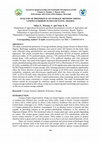
Journal of Agripreneurship and Sustainable Development
The study examined the preference of storage methods among cowpea farmers in Bauchi State, Nigeri... more The study examined the preference of storage methods among cowpea farmers in Bauchi State, Nigeria. Multistage sampling techniques were used to select 202 farmers for the study. Data were collected using questionnaires and analyzed using descriptive statistics and logistic regression. The results revealed that a substantial proportion (47.0%) of farmers preferred phostoxin tablet, 32.7% preferred plastic jerrican, 7.9% preferred PICS bags, 5.0% preferred mental drum, 3.9% preferred actellic 25EC, 2.5% preferred rhumbus and 1.0% preferred actelllic 2% dust. The result of the logistic regression showed pseudo R2 which was 0.847. The results identified among others that quantity stored (P<0.01), effectiveness (P<0.01), durability (P<0.05), availability (P<0.05) and simplicity (P<0.10) significantly affect the choice decision for PICS bags method of cowpea storage. Also, farming experience and simplicity significantly affect the choice decision of jerrican method of stora...
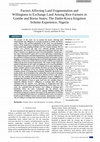
European Journal of Agriculture and Food Sciences
The purpose of this study was to examine the factors affecting land fragmentation and willingness... more The purpose of this study was to examine the factors affecting land fragmentation and willingness to exchange farmland in Gombe and Bornu states, Nigeria. The statistical population of this study were participating farmers of the Dadin-Kowa Irrigation Scheme in Gombe and Borno state. Using a multi-stage sampling technique and Taro Yamane formula, 284 rice farmers were selected and data were collected through structured questionnaire. The result of the Tobit regression model shows that the value of the F-Statistics was significant at one% level of probability. Furthermore, the value of the Pseudo R square (R2) was 0.34, indicating a relationship of 34% influencing factors and land fragmentation. The analysis indicated that the coefficient of distance of farm to homestead (0.041) and number of farm holdings were positively influencing the level of land fragmentation while the coefficients of farm size (-0.047) and farm income (-0.054) were negatively influencing the level of land frag...
The main objective of the study was to analyse costs and returns in egg production in Bauchi and ... more The main objective of the study was to analyse costs and returns in egg production in Bauchi and Gombe metropolises. A number of 29 commercial poultry egg entrepreneurs were purposively selected and interviewed using structured questionnaires. The analysis of the cost structure revealed that feed accounted for about 76% of the total cost of production, while the depreciation on layer stock represented about 90% of the total fixed cost.
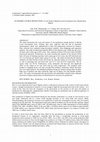
The study determined the costs and returns of rice production among farmers in Bauchi Local Gover... more The study determined the costs and returns of rice production among farmers in Bauchi Local Government Area. Primary data were collected with the aid of structured questionnaires which were administered to fifty (50) purposively selected rice farmers. Data collected were analyzed using descriptive statistics, farm budgeting and regression analysis. The study revealed that majority (40%) of the farmers were within the age of 41-50 years with a mean age of 40.5 years. Also, majority of them (72%) were males and 80% had formal education. Furthermore, the result revealed that majority of the farmers (42%) had 1-10 years of farming experience and a mean age of 14.1 years, also 42% had farm size of 1.5-2.4 hectare per farmer with a mean of 2.25 ha . The study revealed that the farmers realized a net farm income of N33, 822.29 per ha. Also the returns on every naira invested as well as operating ratio and fixed ratio were 0.77, 0.45 and 0.14 respectively. The R-square value was 93.1%, Furt...
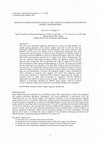
The issue of low agricultural output has continued to be a concern to Niger Republic. The rapidly... more The issue of low agricultural output has continued to be a concern to Niger Republic. The rapidly growing population of the country requires more food. Up till now however, agricultural supplies have not matched up with demands in the country. Related to this problem is the low pace in the adoption and use of agricultural technologies. This study examined the extent of adoption of improved seeds developed by the National Institute of Agricultural Research (INRAN) by farmers in Madarounfa district. Data were collected from 120 farmers randomly selected from 12 villages of the district of Madarounfa. The data were analyzed using simple descriptive statistics and regression analysis. Findings from the study revealed that 59% of respondents fell within the range of 20 to 49 years, 56% are educated, and the average farming experience is 39 years. The study also revealed that the average farm size cultivated is 3 ha, while 90% of land are inherited and donated in the study area. The resul...
This study evaluates the risk management strategies among maize crop farmers in Bauchi State, Nig... more This study evaluates the risk management strategies among maize crop farmers in Bauchi State, Nigeria. Descriptive statistics and other models were used for data analysis. The study revealed that 55. 5% of the farmers were females with mean age of 42 years, 7(17), 2021 Analysis Discovery Agriculture ISSN 2347–3819 EISSN 2347–386X
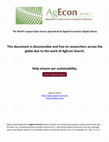
The study was conducted in Bauchi Local Government Area of Bauchi State- Nigeria, to examine the ... more The study was conducted in Bauchi Local Government Area of Bauchi State- Nigeria, to examine the economics of sorghum production. Sixty farmers were randomly chosen and data were collected using a well prepared questionnaire supplemented with oral interview between April and May,2011. The data were analysed using simple descriptive statistics, farm budgeting model and Cobb Douglas production model. The result showed that majority (51%) of the farmers fell between the ranges of 40-49 years, 53% had one form of education or another and 98% of them were married. The result also revealed that farmers in the study areas obtained a net farm income of N 14, 400 per hectare and N 1.79 as return per Naira invested with an operating ratio, gross ratio and fixed ration of 0.47, 0.55 and 0.08 respectively. The regression analysis revealed an R2 value of 64.0% and the coefficients of labour, fertilizer and herbicide were found to be significant (P<0.05) with positive signs, while seed was fou...

The study examined the effect of socio-economic factors on the adoption of ginger (Zingiber offic... more The study examined the effect of socio-economic factors on the adoption of ginger (Zingiber officinal) production technologies in Southern Kaduna State of Nigeria. 200 respondents were randomly selected for this study. Data were collected by means of questionnaires and analyzed using descriptive and inferential statistics. The result revealed that the average age of the respondents was 35.5 years, household size was 10 persons, farm size was 2.55 ha and years of farming experience constituted 15.5 years. The result also revealed that 62.70% of the respondents were married and 84.00% attained one form of education or the other. The result also revealed that educational level and scale of farming influenced the adoption of ginger farming innovations at P ≤ 0.05. It was concluded that the level of education attained by a farmer and his/her scale of farming ease the farmers’ ability to adopt improved ginger farming innovation hence a higher productivity level. It was recommended that ex...

Uploads
Papers by Rabiu Mohammed Sani